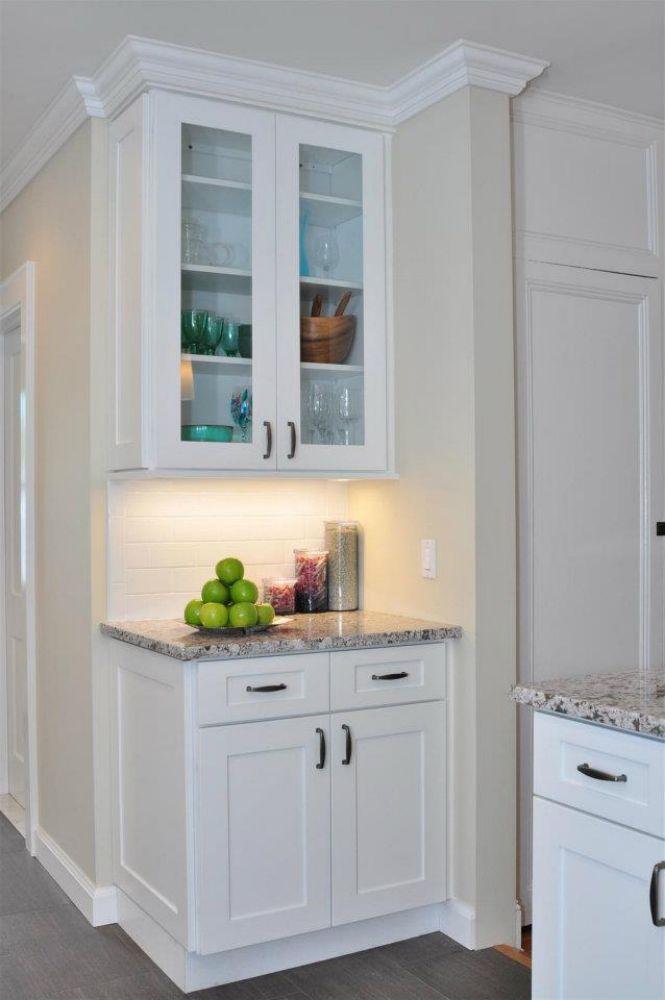Introduction to Cabinet Color Pairing
Kitchen design trends have increasingly embraced the concept of two-tone cabinetry, which combines lighter base cabinets with darker upper cabinets. This approach adds visual interest, depth, and sophistication to the space. Forevermark Gramercy White cabinets, known for their smooth, timeless white finish and versatility, are an excellent choice for such combinations.
Pairing Gramercy White base cabinets with darker upper cabinets can create contrast, enhance architectural features, and complement countertops, backsplashes, and flooring. However, achieving a cohesive and aesthetically pleasing result requires careful planning, understanding of color theory, and attention to layout, lighting, and finishes. This article explores the principles, design considerations, and practical tips for pairing Gramercy White cabinets with darker upper cabinets.
Why Two-Tone Cabinets Are Popular
Two-tone cabinetry has gained popularity for several reasons:
-
Visual Contrast: Mixing light and dark colors creates an eye-catching contrast that elevates kitchen aesthetics.
-
Depth and Dimension: Two-tone designs make kitchens appear larger and more dynamic, breaking up monotony.
-
Personalization: Homeowners can express their style by choosing colors that reflect their preferences, from classic to contemporary.
-
Design Flexibility: Lighter base cabinets provide brightness and openness, while darker upper cabinets introduce sophistication and balance.
Gramercy White, with its neutral and versatile finish, works particularly well as a base color, complementing a wide range of darker upper cabinet shades.
Choosing the Right Dark Upper Cabinet Color
When pairing Gramercy White cabinets with darker upper cabinets, color selection is key. Popular options include:
-
Charcoal or Slate Gray: Offers a modern, sleek appearance that contrasts beautifully with white bases.
-
Deep Navy Blue: Creates a bold, contemporary look while maintaining sophistication.
-
Espresso or Chocolate Brown: Adds warmth and richness, ideal for traditional or transitional kitchens.
-
Black or Graphite: Provides high contrast for dramatic, modern designs.
Consider undertones when selecting colors: cool-toned whites pair best with cool grays or blues, while warm whites complement rich browns or deep greens.
Materials and Finishes
Both Gramercy White and darker upper cabinets should have compatible finishes to ensure a cohesive look:
-
Matte or Satin Finish: Smooth finishes prevent glare and create a soft, modern appearance.
-
Glossy Finish: Adds a reflective quality, enhancing light distribution, but may highlight fingerprints.
-
Wood Veneers: Natural or stained wood for upper cabinets introduces texture and warmth while contrasting with smooth Gramercy White bases.
Ensuring a consistent or complementary finish prevents visual clash and promotes a unified design.
Design Principles for Two-Tone Kitchens
Several design principles help achieve balance and harmony when pairing Gramercy White cabinets with darker upper cabinets:
-
Balance Light and Dark: Ensure the darker color does not overwhelm the space by using it primarily on upper cabinets and incorporating lighter countertops or backsplashes.
-
Maintain Continuity: Extend dark accents, such as hardware, lighting fixtures, or bar stools, to tie the design together.
-
Consider Height and Scale: Taller kitchens can handle darker upper cabinets more easily, while shorter spaces may require lighter walls or reflective backsplashes to prevent a closed-in feel.
-
Incorporate Transitional Elements: Combining wood tones or mixed materials can soften the contrast and create visual cohesion.
-
Lighting Matters: Proper lighting highlights the color contrast and enhances the overall kitchen aesthetic. Under-cabinet lighting, pendant lights, and recessed lighting play a crucial role.
Practical Installation Considerations
Installing two-tone cabinets requires careful planning:
-
Cabinet Layout: Start with Gramercy White base cabinets for a light, open foundation. Upper cabinets can be darker, ensuring alignment with appliance and wall features.
-
Hardware Coordination: Consider matching or complementary hardware for both base and upper cabinets to create a seamless look.
-
Edge Protection: Darker finishes can show dust and scratches more easily; protective finishes or careful handling during installation is recommended.
-
Consistent Cabinet Lines: Choose cabinet styles with consistent profiles to avoid visual dissonance between the two tones.
Professional installation can help ensure precise alignment, especially when combining two different cabinet colors and finishes.
Styling and Design Tips
Pairing Gramercy White with darker upper cabinets opens possibilities for creative styling:
-
Countertops: Light countertops, such as quartz or marble, contrast nicely with darker upper cabinets while complementing white bases.
-
Backsplashes: Consider subway tiles, herringbone patterns, or neutral mosaics to unify the two-tone look.
-
Flooring: Medium-toned wood or tile floors can balance the contrast without overpowering the room.
-
Accents and Accessories: Metallic finishes (brass, bronze, or chrome) can tie together light and dark elements.
-
Open Shelving: Incorporate floating shelves in wood or dark tones to break up solid blocks of color and add visual interest.
These design choices enhance the aesthetic appeal of Gramercy White paired with darker upper cabinets.
Benefits of Pairing Gramercy White with Dark Upper Cabinets
-
Visual Interest: Creates a striking yet harmonious focal point in the kitchen.
-
Flexibility: Works in modern, transitional, and traditional kitchens.
-
Light Management: Lighter base cabinets help maintain brightness and openness, preventing the space from feeling closed in.
-
Increased Depth: Darker upper cabinets draw the eye upward, enhancing the perception of height and depth.
-
Timeless Appeal: White and dark two-tone designs remain popular and versatile for long-term use.
Potential Challenges and Solutions
-
Risk of Overwhelm: Dark upper cabinets may dominate smaller kitchens. Solution: Use lighter walls, reflective backsplashes, or open shelving to lighten the visual weight.
-
Cleaning Maintenance: Dark finishes show dust and fingerprints more easily. Solution: Regular cleaning and finishes that resist smudges help maintain a polished appearance.
-
Design Coordination: Choosing the wrong undertone may create a clash between cabinets. Solution: Use paint or cabinet samples to test color combinations before final installation.
By addressing these challenges, homeowners can successfully pair Gramercy White with darker upper cabinets without compromising aesthetics or functionality.
Conclusion
Forevermark Gramercy White cabinets can be effectively paired with darker upper cabinets to create a striking, sophisticated two-tone kitchen design. Proper planning, color selection, finish compatibility, and attention to balance and proportion are key to achieving a cohesive, visually appealing result. Light Gramercy White bases provide brightness and openness, while darker upper cabinets add depth, contrast, and elegance.
With thoughtful design choices, appropriate lighting, and careful installation, this combination can enhance kitchen aesthetics, improve visual depth, and provide a timeless, versatile solution for modern or traditional kitchens. Whether DIY or professionally installed, Gramercy White cabinets paired with darker upper cabinets are a stylish, functional choice for homeowners seeking both beauty and durability.
Frequently Asked Questions
Q1: Which dark colors work best with Gramercy White cabinets?
A: Charcoal gray, navy blue, espresso brown, and black are popular choices that complement Gramercy White bases.
Q2: Can this two-tone design be used in small kitchens?
A: Yes, but lighter walls, reflective backsplashes, and under-cabinet lighting help prevent the space from feeling cramped.
Q3: Do darker upper cabinets require more maintenance?
A: Darker finishes show dust and fingerprints more easily, so regular cleaning is recommended.
Q4: Should hardware match both cabinet colors?
A: It is best to choose hardware that complements both base and upper cabinets to maintain a cohesive design.
Q5: Is professional installation recommended for two-tone cabinet designs?
A: Professional installation ensures precise alignment, proper leveling, and careful handling of different finishes, which is especially helpful for complex layouts or high-contrast designs.

